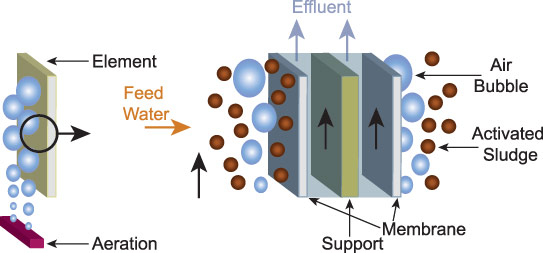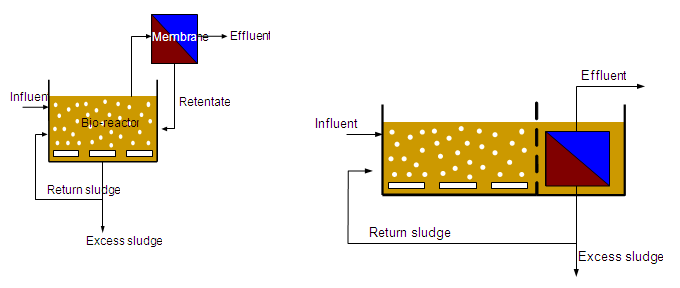Why Membrane Bioreactor Solutions Are Ideal for Sustainable Water Treatment
Why Membrane Bioreactor Solutions Are Ideal for Sustainable Water Treatment
Blog Article
How Membrane Layer Bioreactors Are Transforming Water Filtration Solutions
The emergence of membrane layer bioreactors (MBRs) represents a substantial development in the area of water purification, combining organic treatment procedures with advanced membrane layer filtration modern technologies. This integration not just boosts the top quality of treated effluent but likewise addresses city room restrictions, making MBRs specifically suitable for largely booming areas. As international water scarcity escalates, the role of MBRs in assisting in potable water reuse and sustainable water administration comes to be increasingly essential. The effects of this modern technology extend beyond effectiveness-- what difficulties and possibilities lie ahead for its widespread application?
Summary of Membrane Bioreactors
Membrane bioreactors (MBRs) stand for a substantial innovation in water filtration innovation, as they integrate biological therapy procedures with membrane filtration. This integration boosts the performance of wastewater therapy by using microorganisms to degrade natural contaminants while concurrently employing semi-permeable membrane layers to different treated water from suspended pathogens and solids.
The MBR system typically is composed of a biological reactor where the microbial populace metabolizes pollutants, followed by a membrane layer filtering system that maintains biomass and enables only clean water to travel through. This double functionality causes higher effluent quality contrasted to conventional therapy techniques. MBRs can be run in both batch and continuous circulation modes, using flexibility in layout and application.
They additionally enable the healing of water for reuse, therefore adding to water sustainability initiatives. In general, MBRs are at the leading edge of boosting water treatment efficiency and high quality, showcasing the capacity for cutting-edge remedies in environmental management.
Advantages of MBR Innovation
The assimilation of organic therapy with membrane layer filtration offers various advantages for water purification procedures. Among the main advantages of Membrane layer Bioreactor (MBR) modern technology is its capacity to effectively remove both inorganic and natural contaminants, leading to premium effluent. The membranes serve as a physical barrier, avoiding suspended solids and microorganisms from going through, which enhances the total safety and integrity of treated water.
Additionally, MBR systems call for a smaller sized impact compared to traditional treatment methods, allowing for more reliable room use. This small design is particularly advantageous in city settings where land is limited. MBRs also show functional flexibility, accommodating differing influent high qualities and flow prices without substantial performance degradation.
In addition, the procedure provides enhanced nutrient elimination abilities, particularly for nitrogen and phosphorus, which are critical for protecting against eutrophication in getting waters. The decreased sludge manufacturing connected with MBR technology additionally equates to lower disposal prices, making it an affordable solution in the future - Membrane Bioreactor. In general, the benefits of MBR innovation position it as a leading option for innovative and lasting water purification systems, attending to both environmental and financial concerns
Applications in Water Purification
Applications of Membrane Layer Bioreactor (MBR) innovation in water filtration are diverse and impactful, addressing different therapy needs throughout numerous industries. MBRs properly combine organic therapy processes with continue reading this membrane layer purification, making them optimal for metropolitan wastewater treatment, industrial effluent monitoring, and even drinkable water reuse campaigns.
In local setups, MBRs are increasingly employed to enhance the high quality of dealt with wastewater, permitting conformity with rigorous discharge regulations and helping with the recycling of water for irrigation and non-potable uses. Their small style likewise makes them appropriate for metropolitan settings where room is restricted.
Industrially, MBR technology is made use of to treat process water and wastewater, particularly in markets such as food and beverage, drugs, and textiles. By properly getting rid of impurities and put on hold solids, MBRs aid sectors decrease ecological influences while recouping useful sources from wastewater streams.
Additionally, MBRs are getting traction in decentralized water treatment applications, where small-scale systems can be released in remote locations or establishing regions. This adaptability enables areas to attain lasting water administration services, enhancing accessibility to tidy water while minimizing reliance on traditional therapy techniques.
Situation Studies and Success Stories

In one more instance, a textile manufacturing center in Bangladesh adopted MBR modern technology to address its wastewater obstacles. The system minimized chemical oxygen demand (COD) degrees from 1,200 mg/L to less than 100 mg/L, hence meeting governing requirements and significantly lessening environmental influence.
The University of Cape Community's MBR installation has actually proven reliable in treating greywater for non-potable reuse on school. This project not only preserves drinkable water yet also works as an educational version for sustainable methods.
In addition, a seafood processing plant in Norway used MBR modern technology to treat effluents containing high degrees of raw material, accomplishing over 90% pollutant elimination. These study underscore MBR innovation's versatility and its important duty in enhancing water high quality throughout varied applications.
Future of Water Treatment Solutions
As global water shortage and air pollution challenges heighten, cutting-edge water treatment services are ending up being significantly vital to guarantee lasting accessibility to tidy water. The future of water therapy hinges on the integration of advanced innovations that improve the performance and performance of filtration procedures. Membrane layer bioreactors try this (MBRs) go to the forefront of this evolution, combining biological treatment with membrane filtration to produce top quality effluent appropriate for different applications.

Arising fads such as source healing from wastewater, including nutrients and energy, will further change therapy facilities into environmentally friendly hubs. In addition, innovations in nanotechnology and membrane layer materials promise boosted efficiency and durability of filtration systems.

Final Thought
Their function in safe and clean water reuse and sustainable water administration highlights their value in addressing worldwide water shortage obstacles. Continued research study and advancement will certainly further improve the effectiveness and fostering of visit site MBR technology, guaranteeing a durable future for water therapy remedies.
The development of membrane bioreactors (MBRs) stands for a substantial innovation in the field of water purification, merging biological treatment processes with innovative membrane layer purification modern technologies. As global water scarcity heightens, the function of MBRs in promoting safe and clean water reuse and lasting water monitoring comes to be significantly critical. They also enable the recovery of water for reuse, thus contributing to water sustainability initiatives.As global water deficiency and air pollution obstacles escalate, cutting-edge water therapy remedies are coming to be progressively necessary to make sure sustainable access to clean water. Their duty in safe and clean water reuse and lasting water administration highlights their significance in addressing international water deficiency difficulties.
Report this page